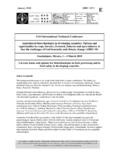Transcription of Good Agricultural and Manufacturing (Handling) …
1 good Agricultural and Manufacturing ( handling ). safety and food Defense Practices as Part of Fresh Blueberry Farming, Packing and Distribution NORTH AMERICAN BLUEBERRY COUNCIL. 80 Iron Point Circle, Suite 114. Folsom, California 95630. Phone (916) 983-2279 Fax (916) 983-9370. Website: 1. good Agricultural and Manufacturing ( handling ) safety and food Defense Practices as Part of Fresh Blueberry Farming, Packing and Distribution March 2010. ACKNOWLEDGEMENT. The North American Blueberry Council (NABC) has adapted this document from the Michigan State University Extension publication titled good Agricultural Practices for food safety in Blueberry Production: Basic Principles . which was prepared by Anamaria Gomez Rodas, Les Bourquin, Carlos Garcia Salazar, Anamaria Varela-Gomez and John C. Wise from the Department of Entomology, Trevor Nichols Research Complex; Department of food Science and Human Nutrition; MSU Extension Central Region- Ottawa County.
2 The NABC wishes to thank these individuals for their work and for the opportunity to adapt their publication for use by blueberry growers and handlers throughout North America. TABLE OF CONTENTS. Blueberry GAP Basic Principles .. Page: 5. I. Farm History .. 8. Previous land use .. 8. Adjacent land use .. 8. II. Water .. 8. Hazards associated with water .. 8. Agricultural water .. 8. Best Management Practices for Irrigation water .. 9. Processing water .. 10. III. Worker Health and Hygiene .. 10. Control of potential microbial hazards .. 11. Prevention .. 11. Train Workers in good Hygiene and Document the Training .. 11. U-Pick operations .. 12. Hand washing .. 12. Correct way to wash hands .. 13. Alternative good Hygienic Practices .. 13. Drinking water .. 13. Toilet use .. 14. First Aid .. 14. Blood and Bodily Fluid Contamination 14. Personal hygiene .. 14. 2. IV. HACCP .. 15. What does all this mean? .. 15. What does clean mean? .. 16.
3 The 7 principles of HACCP .. 16. Conducting a hazard analysis .. 16. How to tell a Control Point from a Critical Control Point .. 17. Types of charts .. 17. Establishing critical limits and monitoring procedures .. 17. Establishing corrective actions and verification processes .. 17. Establishing record keeping and documentation procedures .. 18. V. Field Sanitation .. 18. Part 500 field sanitation .. 18. Drinking water .. 19. Toilet and hand washing facilities .. 19. Sewer disposal .. 20. Pre-harvest field sanitation .. 20. Harvest field sanitation .. 20. Equipment maintenance .. 21. Record Keeping .. 21. VI. Harvest .. 21. Fresh pack - Manual harvest considerations .. 21. Rules for Hand Pickers .. 22. Processing blueberries mechanical harvest considerations .. 22. Rules for blueberry mechanical harvest .. 23. VII. Post-Harvest .. 23. General fresh packing/sorting considerations .. 23. Processed blueberries .. 24. Wash water quality.
4 24. Processing water .. 24. Water disinfection .. 24. VII. Packing/Shipping Facilities .. 25. Packing house general housekeeping .. 25. Containers and pallets .. 25. Cold storage facilities .. 26. Packing house sanitation .. 26. Worker hygiene .. 26. Containers and Packaging .. 26. Packing facility maintenance .. 27. Pest control .. 27. 3. IX. Pesticide Use and safety .. 28. Pesticide use and worker safety .. 28. Pesticide use guidelines .. 28. Pesticide selection .. 28. Pesticide handling .. 28. Pesticide application .. 28. Pesticide storage .. 28. Use permits and posting requirements .. 28. Pesticide application record keeping .. 29. Private/Commercial applicator certification .. 29. Documentation of training .. 29. Applicator, mixer/loader and field worker safety requirements .. 29. Pesticide disposal .. 29. Worker safety .. 30. X. Trace Back .. 30. Suggested trace back procedures .. 30. XI. Transportation .. 31. Appendix A: Short introduction to blueberry production.
5 33. Appendix B: Common terms, acronyms and definitions .. 34. Appendix C: HACCP Materials .. 39. Appendix D: Signs and symptoms of common infections diseases .. 45. Appendix E: Checklists .. 47. Published March 2010 by the North American Blueberry Council 80 Iron Point Circle, Suite 114; Folsom, California 95630. 4. BLUEBERRY GAP/GMP BASIC PRINCIPLES. The aim of this guide is to insure consumer protection from eating blueberries, recognizing that we not only are producers but also consumers. BACKGROUND. Consumption of fresh fruits and vegetables has increased dramatically during the past 10-15 years. However, food borne illnesses attributed to produce have also risen to about 15% of the total food borne illnesses in the USA. Produce food borne illnesses have been associated with pathogenic bacteria like Salmonella spp., Eschericia coli O157:H7, Shigella; with viruses like Hepatitis, and parasites like Crystoporidium parvum, Giardia lambdia and Cyclospora cayetanensis.
6 This increase in the incidence of foodborne illnesses has been the consequence of higher per capita consumption, larger distribution markets, better reporting and follow-up, and other factors. Blueberries are one crop that has grown in popularity thanks to their health attributes and efforts by all responsible for growing, packing and distributing. There has been no foodborne illness case associated with blueberries in the USA, but there has been a hepatitis outbreak associated with blueberries in New Zealand (Calder et al, 2003), and some scares. It has been reported that Salmonella and E. coli O157:H7 are capable of growing in blueberries (Waters and Beuchat, 2004; Tokitkla et al, 2004; Bialca and Demirci, 2007). Moreover, there have been a number of foodborne outbreaks associated with other berries and acid fruits including strawberries (hepatitis A) and raspberries (Cyclospora), in addition, there have been numerous outbreaks linked to Salmonella (lettuce, almonds, tomatoes), E.
7 Coli O157:H7 (spinach, jalapenos, orange juice), and Shigella (green onions) amongst others (). In many, if not all cases, the industry has suffered economically and from a reputation standpoint, both innocent and guilty parties. One case is that of E. coli O157:H7 first associated with tomatoes and later found jalapenos to be the source. This devastated the US tomato industry, especially Florida but also other areas. The Salmonella outbreak in orange juice caused a company to almost go out of business. In the case of raspberries, repeated outbreaks of Crystoporidium have disseminated the Guatemalan berry industry. Foodborne pathogens have been isolated from many fruits and crops like almonds and jalapenos, not associated with foodborne illnesses before have been linked now. Thus, it is important that we as farmers, packers, transporters/distributors, repackers, and retailers and processors pay attention to our production practices in order to insure we never have to face a foodborne outbreak.
8 All it takes is a lot of contaminated berries to have newspapers, lawyers, regulatory agencies, and many others make a bad name for our healthy, nutritious product. As farmers, we have to be alert since most outbreaks of fresh produce are traced back to the farm. In addition to foodborne pathogens, fresh blueberries can also be contaminated with pesticide residues improperly administered or not labeled for the blueberry. Although there are no foodborne cases associated with chemical residues in blueberries, the latest national incidence data reports chemical pesticides above tolerance levels or not labeled for blueberries (USDA, 2009) grown in the USA and imported. This is a concern because we have strict regulations and widely known training and education on how to store, handle and apply chemical pesticides on Agricultural products. It is our duty to be responsible to our consumers and apply chemical pesticides in a responsible manner.
9 Finally, we have had some recalls because of issues at repacking operations. These issues are not our fault but affect our industry. Some of these incidences include a recall of yogurt, one of cereal and a complaint from a school lunch program. In all cases, foreign material was found on the berries, which did not affect the health of consumers, but should have not been in the berries if the repackers followed current good Manufacturing Practices (21 CFR110). 5. In addition to the food safety concerns, the regulatory agencies, including the US FDA, USDA and the Department of Homeland Security, have developed regulations and guidance to insure the protection of food from intentional adulteration. A brief synopsis of this is included in this bulletin. Intentional contamination can occur at the farm or anywhere else in the distribution cycle of the product, resulting in economic losses and/or harm to humans. There are other microorganisms such as fungi and other bacteria that can be pathogens to the plant or the berry, can result in production losses or reduced shelf life, but do not affect the health of consumers.
10 These are spoilage microflora, which should be of concern to us since it affects the quality, the price and the marketability of our product. These microorganisms are many times controlled by similar controls we impose on our product to prevent foodborne hazards. Thus, the incorporation of practices to prevent fruit contamination and human illness from it s consumption will also help us enhance fruit quality and marketability. The US FDA has jurisdiction over the safety of our blueberries, from the farm to the table (inspection for human/consumer safety ). This agency is charged with overseeing that our blueberries are not contaminated and thus do not pose a risk when consumed. At times, this agency can share duties with state health agencies. This is the regulatory agency and is the one that has ultimate decision when a foodborne outbreak happens. In addition, the USDA-AMS has the capacity to inspect and certify our blueberries, in addition to many third parties (certification).





